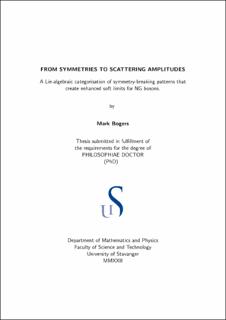| dc.contributor.advisor | Brauner, Tomas | |
| dc.contributor.author | Bogers, Mark | |
| dc.date.accessioned | 2022-11-17T13:23:49Z | |
| dc.date.available | 2022-11-17T13:23:49Z | |
| dc.date.issued | 2022-11 | |
| dc.identifier.citation | From Symmetries to Scattering Amplitudes: A Lie-algebraic categorisation of symmetry-breaking patterns that create enhanced soft limits for NG bosons by Mark Bogers, Stavanger : University of Stavanger, 2022 (PhD thesis UiS, no. 669) | en_US |
| dc.identifier.isbn | 978-82-8439-127-4 | |
| dc.identifier.issn | 1890-1387 | |
| dc.identifier.uri | https://hdl.handle.net/11250/3032473 | |
| dc.description.abstract | The standard calculation of scattering amplitudes in quantum field theory is carried out using a perturbative expansion, that at successive orders contains an escalating number of terms to calculate.
The amplitudes depend on an action, that specifies the properties and interactions of the particles involved in the scattering events. It is worthwhile to establish more direct relationships between the qualities of an action and its scattering amplitudes, not just to refine the formalism, but to simplify certain calculations. To that end, the long wavelength behaviour of the scattering amplitudes of Nambu-Goldstone bosons are investigated. NG bosons are massless scalar particles that exist due to, and whose interactions are principally determined by, the spontaneous breaking of symmetries; they make for good models to study the relations between symmetries and amplitudes. The subject here is specifically NG models with enhanced soft limits, meaning that, as the momentum of one of the particles entering a scattering event goes to zero, the amplitude must vanish as a higher power of that momentum.
This thesis lays out the context and procedures that lead from symmetry breaking to effective actions and finally to the calculation of scattering amplitudes. Using this framework, the relation between Lie algebras and the enhanced soft limits was researched. In the case of a single physical NG boson, a full Lie algebraic categorisation of the models with enhanced scaling of the amplitudes in the soft limit was found: the only non-trivial models were the familiar DBI and galileon actions. For multiple physical NG bosons with enhanced soft limits a Lie algebra was discovered, which is purely determined by its internal, non-redundant symmetries, its affine representation and an invariant symmetric 2-tensor of said representation. From this algebra two infinite classes of models can be derived that are generalisations of the known DBI and galileon multi-flavour theories. The constraints on the amplitudes thus suffice to create categorisations of the Lie algebras. Due to the special properties of their soft limits, the resulting models may be interesting to high-energy physics and cosmology. | en_US |
| dc.language.iso | eng | en_US |
| dc.publisher | University of Stavanger, Norway | en_US |
| dc.relation.ispartofseries | PhD thesis UiS; | |
| dc.relation.ispartofseries | ;669 | |
| dc.rights | Navngivelse 4.0 Internasjonal | * |
| dc.rights.uri | http://creativecommons.org/licenses/by/4.0/deed.no | * |
| dc.subject | fysikk | en_US |
| dc.subject | physics | en_US |
| dc.subject | matematikk | en_US |
| dc.subject | kosmologi | en_US |
| dc.title | From Symmetries to Scattering Amplitudes: A Lie-algebraic categorisation of symmetry-breaking patterns that create enhanced soft limits for NG bosons | en_US |
| dc.type | Doctoral thesis | en_US |
| dc.rights.holder | ©2022 Mark Bogers | en_US |
| dc.subject.nsi | VDP::Matematikk og Naturvitenskap: 400::Fysikk: 430 | en_US |

